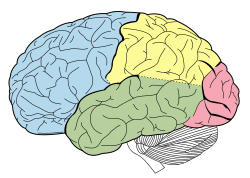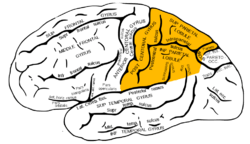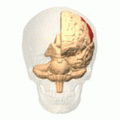Parietal lobe facts for kids
| Brain: Parietal lobe | ||
|---|---|---|
Quick facts for kids
|
||
| Principal fissures and lobes of the cerebrum viewed laterally. (Parietal lobe is shown in yellow) | ||
| Lateral surface of left cerebral hemisphere, viewed from the side. (Parietal lobe is shown in orange.) | ||
| Latin | lobus parietalis | |
| Part of | Cerebrum | |
| Artery | Anterior cerebral Middle cerebral |
|
| Vein | Superior sagittal sinus | |
The parietal lobe is an important part of your brain. It sits at the top and back of your head, right behind the frontal lobe and above the occipital lobe. Think of it as a control center that helps you understand the world around you.
This part of the brain is amazing because it brings together information from different senses. It's especially good at helping you understand where things are in space and how to find your way around. For example, it uses signals about touch, balance, and what you see. This allows your parietal lobe to create a mental map of objects in relation to your own body. This is why you can easily reach out and grab a pencil or know how far away a door is.
The name "parietal" comes from the parietal bone, which is the skull bone covering this part of the brain. The word itself comes from the Latin pariet-, meaning 'wall'.
Contents
What the Parietal Lobe Does
The parietal lobe is like a super-smart computer that processes lots of different signals. It helps you make sense of your body and the space around you.
Understanding Touch and Feeling
One of the main jobs of the parietal lobe is to process information about touch. This includes things like:
- Feeling pressure, like when you press your finger on something.
- Noticing temperature, whether something is hot or cold.
- Sensing pain, which helps protect your body from harm.
- Knowing the texture of objects, like if something is smooth or rough.
This part of your brain also helps you understand where these feelings are coming from on your body. For example, it tells you if you touched something with your hand or your foot.
The parietal lobe is key for your spatial awareness. This means knowing where your body is in space and how it relates to other objects. It helps you:
- Understand directions, like left and right.
- Navigate through a room without bumping into things.
- Judge distances, so you know how far you need to reach for something.
- Mentally rotate objects, which is useful for puzzles or fitting things together.
It combines what you see with what you feel to create a complete picture of your surroundings. This is why you can walk through a crowded hallway without tripping over people or objects.
Body Awareness
This lobe also helps you have a strong sense of your own body. This is called proprioception. It means you know where your arms and legs are, even if you can't see them. For example, you can touch your nose with your eyes closed because your parietal lobe tells you where your hand is in relation to your face. This is super important for everyday activities like walking, running, or playing sports.
Images for kids
See also
 In Spanish: Lóbulo parietal para niños
In Spanish: Lóbulo parietal para niños




